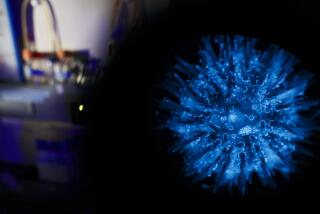Mantis shrimp wear tinted shades to see UV light
- Share via
When you look at a mantis shrimp, you see a vivid lobster-like crustacean whose forearms can strike with the force of a .22-caliber bullet. But when a mantis shrimp looks at you, we have no idea what it sees. That’s because the mantis shrimp possesses one of the most complex eyeballs on the planet, an organ that allows it to perceive a rainbow of colors in both the visible and ultraviolet spectrum without the massive brainpower required for human vision.
Now scientists are one step closer to understanding how mantis shrimp do it. In a new study published Thursday in the journal Current Biology, researchers report that that mantis shrimp use a set of filters to separate ultraviolet light into discrete colors that get picked up by the animals’ photoreceptors.
This is the most extreme example of animals using filters to expand the range of colors they can see, and the first in the UV spectrum, the scientists say.
Like many insects and crustaceans, mantis shrimp (which aren’t actually shrimp) have compound eyes. That means they contain many faceted lenses that each provide a single pixel of visual information.
“You can think of a compound eye as a collection of straws,” said Thomas Cronin, a biologist at the University of Maryland, Baltimore County, and an author of the study. Each straw transmits light to a light-sensitive pigment called a photoreceptor. The mantis shrimp has 16 different photoreceptors (we have only three), and the ones that deal with color sit clustered in the midband, a horizontal stripe of straws that bisects the eyeball.
Researchers have long thought the mantis shrimp’s wide array of photoreceptors and elaborate visual machinery must allow them to see more colors than we could possibly imagine (or as the cartoonist, the Oatmeal, put it, “a thermonuclear bomb on light and beauty”). That idea was debunked by a study this year that showed mantis shrimp don’t distinguish color any better than humans — they just do it quickly and with smaller brains.
However, mantis shrimp still have the privilege of perceiving a whole world lit by ultraviolet light that we will never experience.
In a previous study, scientists measured exactly which ultraviolet wavelengths mantis shrimp see by hooking them up to an electrode and watching which colors elicited a current. They found the shrimp could detect five different frequencies in the deep ultraviolet — also known as UV-B, the dangerous rays that cause sunburns and skin cancer.
But when researchers went looking for the pigments that capture this UV light, they found the mantis shrimp had only two. The animals parse incoming light into distinct colors using a set of filters.
“It’s just as if you were wearing colored sunglasses,” said Daniel Osorio, a neuroscientist at the University of Sussex who was not involved in the study. As the name suggests, filters block some frequencies of light while allowing others to pass through. Skiers capitalize on this, for example, when they wear yellow lenses to block blue light and increase contrast in cloudy conditions.
In the mantis shrimp, these filters consist of molecules called mycosporine-like amino acids, or MAAs. Scientists have previously found MAAs in the skin of many fish and crustaceans, which presumably obtain them from their diet since only bacteria and algae can produce the compounds.
“The big benefit to marine animals is that they act just like the sunscreen you buy in the pharmacy,” Cronin said. But scientists have also spotted MAAs in the eyes of aquatic creatures, which made Cronin and his colleagues suspect they might play a role in mantis shrimp vision.
Eventually, the researchers discovered that mantis shrimp mix and match their four unique MAA filters and two photoreceptors to identify five different colors of UV light.
Other animals, such as butterflies and birds, use a similar approach with red filters, so the idea isn’t completely new, Osorio said.
“What’s surprising and new here is to see a similar sort of thing done in the UV,” he said.
But why the shrimp evolved this capacity in the first place remains a mystery.
“What you can say is that it didn’t just happen by chance — natural selection led to the evolution of this system,” Osorio said. The mechanism is simply too complex and finely tuned. The researchers suggest UV vision might aid in communication by, for instance, alerting shrimp to the presence of other shrimp, whose shiny lethal appendages strongly reflect UV light. But really, no one knows.
That’s because scientists can’t go down into the mantis shrimp’s world and look around.
“We can make instruments that display their world in colors we can see,” Cronin said, “but whether that has any thing to do at all with what a mantis shrimp sees is anybody’s guess.”
For all things science, follow me @ScienceJulia





